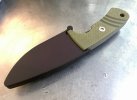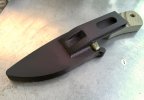- Joined
- Sep 12, 2007
- Messages
- 338
Maybe you have seen my post in KITH with the keyhole bolster. I machined it on a manual mill but even before I started I had this thought that this would be a good application for a 3D printing technology. So I found a service that will do that for you (pretty convenient with immediate online quoting based on the 3D model) and ordered two sample pieces.
They just arrived today.
Overall I am quite impressed.
I can see some faint lines/artifacts of the manufacturing process, but nothing unexpected.
I ordered slightly oversized variant to account for shrinkage (which may have been too cautious) and allowance for further machining/sanding/finishing, especially at the mouth where the blade will be fitted. The dimensions are very good, within the tolerances specified for the technology/material (apparently it is at least +-0.2mm which was achieved). For example the thickness was 14 mm and it came to 13.9 mm.
I paid about 48 Euro for two pieces (+20 for shipping). I can not make it that cheap no way. But of course this is because it was made in PRC. Quotes from EU were prohibitively expensive. I do not mention the specific service as I do not want to promote one specific vendor, I mostly want to mention the technology - so that you have it in your toolbox if you don't already.




Tom Lipton mentioned this technology in one of his videos, I have thinking about it since. You will not go wrong watching this.
They just arrived today.
Overall I am quite impressed.
I can see some faint lines/artifacts of the manufacturing process, but nothing unexpected.
I ordered slightly oversized variant to account for shrinkage (which may have been too cautious) and allowance for further machining/sanding/finishing, especially at the mouth where the blade will be fitted. The dimensions are very good, within the tolerances specified for the technology/material (apparently it is at least +-0.2mm which was achieved). For example the thickness was 14 mm and it came to 13.9 mm.
I paid about 48 Euro for two pieces (+20 for shipping). I can not make it that cheap no way. But of course this is because it was made in PRC. Quotes from EU were prohibitively expensive. I do not mention the specific service as I do not want to promote one specific vendor, I mostly want to mention the technology - so that you have it in your toolbox if you don't already.




Tom Lipton mentioned this technology in one of his videos, I have thinking about it since. You will not go wrong watching this.


